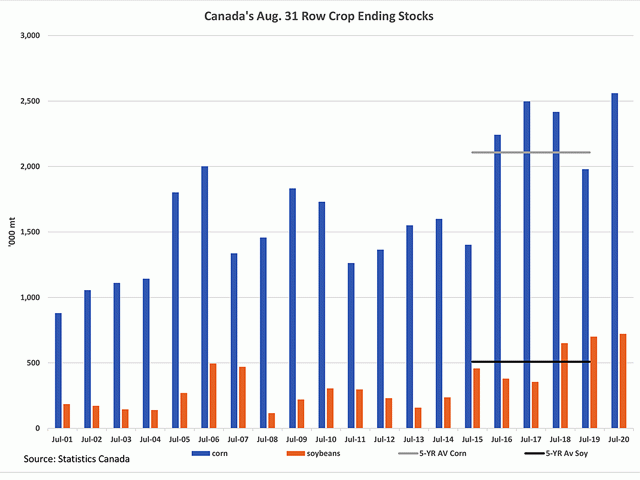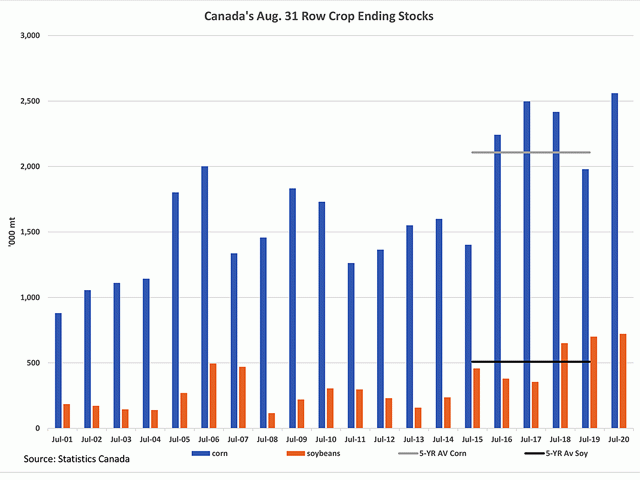Canada Markets
Canada's August Merchandise Trade
Canada's trade deficit with the world fell slightly in August and for the first time in three months, as both exports and imports fell during the month. Agriculture exports were not mentioned in any way in the summary, although there was a mention of the Port of Montreal strike that lasted almost two weeks and may have had a minor detrimental effect on grain and products shipments. As well, the Canadian dollar strengthened 1.5 cents against the USD during the month, also having a detrimental effect on movement.
Exports in the broad Farm, fishing and intermediate food products category totaled $3.771 billion in August, down from July but close to the previous four-month average.
Today, the World Trade Organization released forecasts that call for a 9.2% reduction in global merchandise trade in 2020, with a rebound of 7.2% forecast for 2021. The risks noted are more lock-downs along with increased protectionism.
Each month, we look at the exports of miscellaneous crops and products, with a focus on crops where monthly data provides a more complete picture when compared to the CGC's weekly data.
Canada's lentil exports totaled 211,601 metric tons in August, the lowest monthly movement seen in seven months but still quite likely a record movement for August and well-above the five-year average of close to 82,000 mt. Of this volume, 50% was shipped to India with Turkey and the United Emirates a distant second and third. The current crop year forecast from Agriculture and Agri-Food Canada shows 2.4 mmt of exports for 2020-21, down from 2.7 mmt in 2019-20, while the first month of activity shows exports slightly ahead of the pace to meet this forecast.
P[L1] D[0x0] M[300x250] OOP[F] ADUNIT[] T[]
Canada's dry pea exports were reported at 90,140 mt in August, the lowest monthly volume shipped in any month in more than three crop years and the lowest August volume shipped in seven years, a slow start to the crop year. Of this volume, 50% was shipped to China, while the 44,778 mt shipped in August is well-below the four-month average of 204,777 mt. August shipments represent 79.5% of the volume shipped in August 2019 and 47.8% of the five-year average for this month, while representing 2.4% of the current 3.8 mmt forecast, well-behind the steady pace needed to reach this target although there are 11 months left in the crop year.
Chickpea exports in August totaled 6,619 mt, down from July and slightly below the volume shipped in the same month in 2019. This volume represents 93.7% of the five-year average for August, while represents 5.3% of the current AAFC forecast of 125,000 mt, slightly behind the pace needed to reach this volume.
Canary seed exports were reported at 8,499 mt in August, a slow start to the crop year. This represents 62.6% of the same month in 2019-20 and 77.2% of the five-year average. The current forecast released by AAFC is 155,000 mt while August movement represents 5.5% of this target. Bird seed prices are on the move higher which should attract producer selling.
Flax exports in August were reported at 36,375 mt, the smallest in four months, 146.6% higher than the same month in 2019 and 91.4% of the five-year average. Belgium was the largest buyer for a third month, taking 71% of the month's volume, while the volume shipped to China has fallen for three consecutive months to a modest 1,305 mt. Cumulative exports total 8.1% of the current 450,000 mt export target, very close to the steady pace needed to reach this volume.
Canada's corn exports for August, the last month of the row-crop crop-year, were reported at 32,274 mt, the lowest volume shipped in four months. Roughly 2/3 of this volume was shipped to the United States, while roughly 1/3 of this volume was shipped to the United Kingdom. Crop year exports total 676,700 mt, down 940,000 mt from the previous year, while ending stocks for 2019-20 were reported at 2.560 mmt, a record carryout and considerably higher than the 2 mmt forecast that AAFC released in September.
Statistics Canada tables shows that farm stocks of corn have increased by 918,000 mt year-over-year, while commercial stocks have fallen by 337,000 mt. While total supplies for 2019-20 were reported to fall by 1.3 mmt on smaller beginning stocks and smaller production, exports were down from the previous crop year as well as domestic disappearance, both on the feed and ethanol side of the industry.
August exports of soybeans totaled 159,029 mt, the smallest volume shipped in four months with 43% of the volume shipped to Iran, the largest destination for the month for a third straight month. A modest volume of 8,615 mt was shipped to China, a volume that has fallen for three consecutive months while the smallest volume shipped to China since January of this year. Cumulative exports for 2019-20 total 3.576 mmt, down 2 mmt from 2019-20 on lower supplies and a lack of Chinese business, while ending stocks were reported at a record 721,100 mt as of Aug. 31. This is up 21,300 mt year-over-year, with a rise in farm stocks off-setting a year-over-year decline in commercial stocks.
Canada's canola oil exports totaled 316,421 mt in August, the highest volume shipped in three months. This is a solid start to the 2020-21 crop year, up 13% from the same month in 2019-20 and 30% higher than the three-year average for the month.
Canola meal exports totaled 433,048 mt, the highest volume shipped in four months. This volume is 4% higher than the same month in 2019 while 17.8% higher than the three-year average for this month.
Ethanoyl imports in August are reported at 131 million liters, the largest monthly volume imported in 23 months. DTN research shows Canada as the top market for U.S. ethanol exports in August, with 36% of exports destined for Canada. Imports over the January-through-August period are reported at 758 million liters, down 2.6% from the same period in the previous year.
Cliff Jamieson can be reached at cliff.jamieson@dtn.com
Follow him on Twitter @Cliff Jamieson
© (c) Copyright 2020 DTN, LLC. All rights reserved.





Comments
To comment, please Log In or Join our Community .